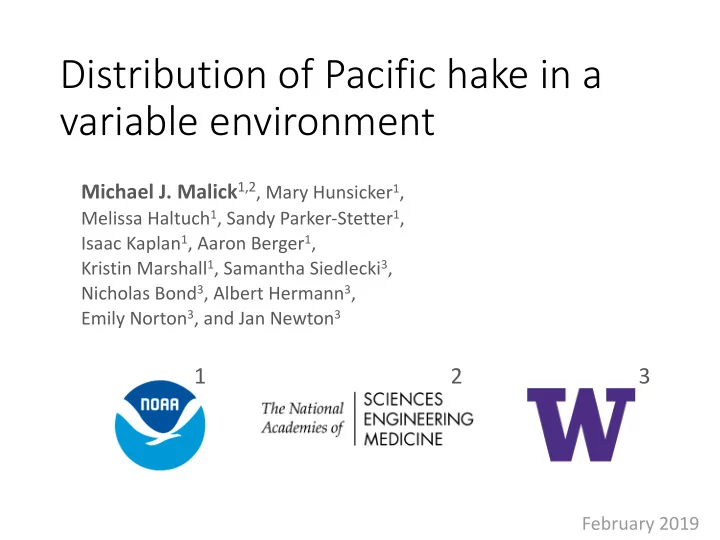

Distribution of Pacific hake in a variable environment Michael J. Malick 1,2 , Mary Hunsicker 1 , Melissa Haltuch 1 , Sandy Parker-Stetter 1 , Isaac Kaplan 1 , Aaron Berger 1 , Kristin Marshall 1 , Samantha Siedlecki 3 , Nicholas Bond 3 , Albert Hermann 3 , Emily Norton 3 , and Jan Newton 3 1 2 3 February 2019
Variability in summer spatial distribution MSE 2
Internal drivers External drivers Temperature Population size Ocean currents Age structure Prey availability 3
Does variability in ocean environmental conditions explain across-year changes in Pacific hake biomass distribution? 4
Does variability in ocean environmental conditions explain across-year changes in Pacific hake biomass distribution? 5
Hake biomass data 1995 1996 1997 1998 54.8 1999 2000 2001 Acoustic survey • 2002 2003 12 years • 2004 Hake survey 2005 2006 36.6—54.8°N transects • 2007 2008 2009 2010 2011 2012 36.6 2013 2014 2015 2016 2017 6
Temperature at 100 m 2007 7
Temperature at 100 m Warmer than average Cooler than average 8
Temperature at 100 m Warmer than average Cooler than average 9
Temperature at 100 m Warmer than average Cooler than average 10
How is temperature at 100 m related to hake biomass distribution?
Spatially variable temperature effects Red = positive correlation • between temperature at 100 m and hake biomass Blue = negative correlation • between temperature at 100 m and hake biomass Black dots = locations with a • statistically significant temperature effect 12
Spatially variable temperature effects 13
Spatially variable temperature effects 14
Spatially variable temperature effects When hake are found north of 50°N, there tends to be more of them than average in warmer years When hake are found off WA and S. Van. Is., there tends to be less of them than average in warmer years 15
Biomass distribution by age-group 16
Is the effect of temperature at 100 m the same across age- groups?
Age-specific temperature effects 18
Age-specific temperature effects No effect 19
Age-specific temperature effects No effect 20
How can knowledge about ocean environmental effects on hake biomass distribution be used?
Seasonal forecasting Decision lead time 1—10 days 1—6 months decades—centuries Weather Seasonal Climate forecasting forecasting projections Forecast skill Lead time 22 Hobday et al. (2016) Fisheries Oceanography
Spatially variable temperature effects Seasonal forecasts of spatial distribution Decision lead time 1—6 months Seasonal forecasting 23
Acknowledgements Collaborators Advisors Sandy Parker-Stetter Mary Hunsicker Isaac Kaplan Melissa Haltuch Aaron Berger Kristin Marshall Samantha Siedlecki Nicholas Bond Albert Hermann Emily Norton Jan Newton NOAA acoustic survey team 24
Recommend
More recommend